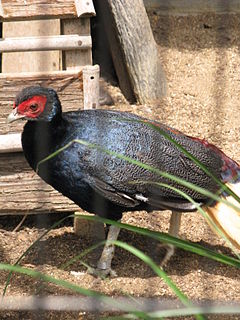 W
WThe gallopheasants are pheasants of the family Phasianidae. The genus comprises 9 species and several subspecies.
 W
WBulwer's pheasant, also known as Bulwer's wattled pheasant, the wattled pheasant or the white-tailed wattled pheasant, is a Southeast Asian bird in the family Phasianidae endemic to the forests of Borneo. It is currently listed as Vulnerable by the IUCN.
 W
WThe crested fireback is a medium-sized, up to 70 cm long, forest pheasant with a peacock-like dark crest, bluish black plumage, reddish brown rump, black outer tail feathers, red iris and bare blue facial skin. The female is a brown bird with short crest, blue facial skin and spotted black-and-white below.
 W
WThe crestless fireback is a species of bird in the family Phasianidae. It is found in Brunei, Indonesia, Malaysia, and Singapore. Its natural habitat is subtropical or tropical moist lowland forests. It is threatened by habitat destruction and the International Union for Conservation of Nature has assessed its conservation status as being "vulnerable".
 W
WEdwards's pheasant is a bird of the pheasant family Phasianidae and is endemic to the rainforests of Vietnam. It is named after the French ornithologist Alphonse Milne-Edwards and first described to science in 1896 The bird's length is 58–65 centimetres (23–26 in) and has red legs and facial skin. The male is mainly blue-black with a crest, and the female is a drab brown bird. The alarm call is a puk!-puk!-puk!.
 W
WThe kalij pheasant is a pheasant found in forests and thickets, especially in the Himalayan foothills, from Pakistan to western Thailand. Males are rather variable depending on the subspecies involved, but all have an at least partially glossy bluish-black plumage, while females are overall brownish. Both sexes have a bare red face and greyish legs. It is generally common and widespread, though three of its eastern subspecies are considered threatened and L. l. moffitti is virtually unknown in the wild.
 W
WSalvadori's pheasant is a landfowl bird of genus Lophura, native to Indonesia. It is found in the mountain rainforests of Sumatra. Thus it is also known as the Sumatran pheasant. This bird was first described in 1879 by the Italian ornithologist Tommaso Salvadori. The species name inornata means "without ornament".
 W
WThe Siamese fireback also known as Diard's fireback, is a fairly large, approximately 80 cm long, pheasant. The male has a grey plumage with an extensive facial caruncle, crimson legs and feet, ornamental black crest feathers, reddish brown iris and long curved blackish tail. The female is a brown bird with blackish wing and tail feathers.
 W
WThe silver pheasant is a species of pheasant found in forests, mainly in mountains, of mainland Southeast Asia, and eastern and southern China, with introduced populations in Hawaii and various locations in the US mainland. The male is black and white, while the female is mainly brown. Both sexes have a bare red face and red legs. It is common in aviculture, and overall also remains common in the wild, but some of its subspecies are rare and threatened.
 W
WSwinhoe's pheasant, also known as the Taiwan blue pheasant, is a bird of the pheasant subfamily in the fowl family Phasianidae. It is endemic to Taiwan. Along with the Mikado pheasant and Taiwan blue magpie, two other Taiwan endemics, the Swinhoe's pheasant is sometimes considered an unofficial national symbol for Taiwan as it bears the colours of the national flag.
 W
WThe Vietnamese pheasant, or Vietnam fireback, was formerly considered a species of gallopheasant, Lophura hatinhensis, but is now considered a variant of Edward's pheasant. Discovered in 1964, it is endemic to central Vietnam. Its range concentrates around Kẻ Gỗ Nature Reserve in Hà Tĩnh Province.